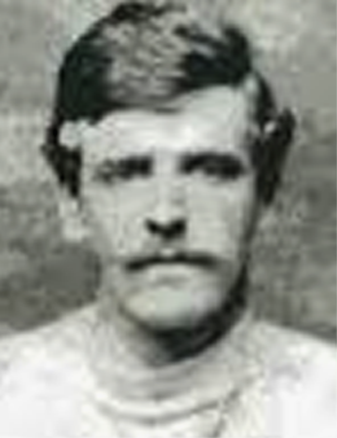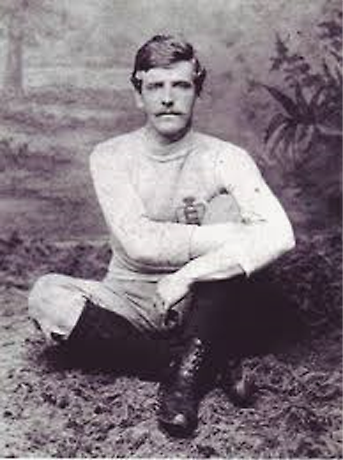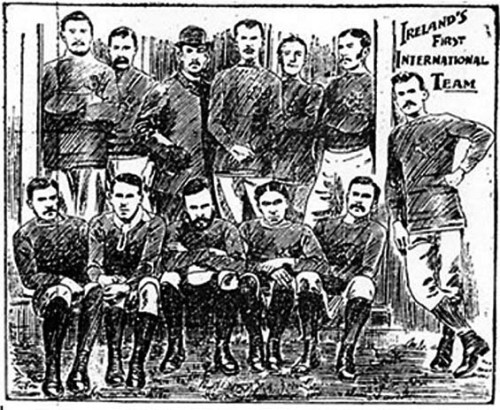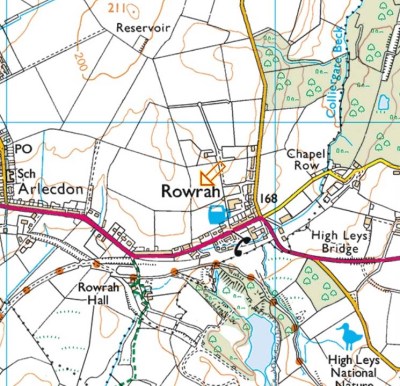Harry Cursham has scored more goals in the F.A Cup competition than any other soccer player in history.
Harry was born at Wilford Grange near Nottingham on November 27th 1859, one of the five sons of William George Cursham, a solicitor. He entered the High School at the age of nine on January 18th 1869, on the same day as his brother, Charles. Harry had three brothers in total. Like him, they all attended the High School. They were Arthur William Cursham, (born 1853), Charles Lambert Cursham, (born 1858), and William Cursham (born 1862). Here is the High School of Harry’s day:

During his school career Harry played for the High School First Team, but only a very few editions of the school magazine, “The Forester”, have survived from this period. Unfortunately, the very few match reports are not particularly detailed, and there is no mention of Harry as a footballer.
Harry does appear as an athlete. He won a 100 yards’ race for boys under eleven at the Annual Athletic Sports in September 1870. This major event in the social calendar of Victorian Nottingham took place at Trent Bridge, with the crowd entertained throughout the two days by the regimental band of the Robin Hood Rifles. “Cursham ii” won “a capital race” for second place, narrowly beating Brewill, “who ran remarkably well for so small a boy” by about two yards. It was only after the end of the race that the apparently easy winner, Anderson, was disqualified for being over age, thus leaving Harry in first place.
After leaving in 1875, Harry transferred to Repton School as a boarder. He remained there until Christmas 1876, and represented the school at both football and cricket. Harry returned to Nottingham in 1877 and joined Notts County for the 1877-1878 season. Both he, and his brother, Arthur, soon became very great favourites with the crowd. Harry was too young to have worn Notts’ wonderful “convict kit”:

On November 3rd 1877, “…these splendidly built players…”, Harry and elder brother, Charles, played for County in their first ever F.A.Cup tie, against the Sheffield Club, for whom Arthur Cursham made an appearance. Arthur, of course, was normally a Notts County player. The match took place at Trent Bridge, and was drawn 1-1. Arthur scored for Sheffield, and Charles for Notts County. The County team included at least four Old Nottinghamians, namely Harry Cursham, Charles Cursham, Thomas Oliver, George Seals, and, possibly, Henry Jessop as a fifth.
In the replay, Arthur scored twice for Sheffield, and County lost 0-3, but Harry was seen as a promising débutant during the season, appearing in the prestigious friendly against Scottish club, Queen’s Park, at Hampden.
Harry soon became a high scoring forward, and scored well in excess of 200 goals in thirteen seasons. “The Football Annual” described him as…
“…one of the best forwards of the day, plays brilliantly on either wing but is particularly effective on the left.”
Elsewhere, he is described as having been:
“…at home on either wing or in the centre, and had good dribbling skills.”
In the 1880s, a third source said that Harry was
“…the most versatile player Notts had during that period, for he was at home anywhere, and was an indispensable member of the English eleven.”
Here is our hero:

On November 16th 1878, Harry played for Notts County in their First Round F.A.Cup tie against Nottingham Forest at Beeston Cricket Ground, Nottingham Forest having waived their right to host the game. The fact that the Forest Recreation Ground was public land meant that it was impossible to charge admission money. Forest won 3-1, in front of a crowd of some 500 spectators, with goals from Turner, Goodyer and Smith. The attendance was the highest ever recorded for a football match in Nottingham. Special excursion trains were used to take them out of the City.
On November 11th 1880, Harry returned to the High School, and appeared on the Forest for the School First XI against the Bank. The match took place on a “merit half-holiday”, and the High School fielded six Old Boys, including Harry and Charles Cursham. The Bank’s team was formidable, with several “players of no small note in the local football world”. The game was fast and even, but the the High School’s players were on top form. They ran out the eventual winners by 4-1.
By now Harry had already played for England on one occasion, against Wales at Wrexham on March 15th 1880. As far as I can trace, this game against the Bank is the only occasion on which a current England international represented the High School in any sport.
In the 1881-1882 season, Harry played in the F.A.Cup tie between Notts County and Wednesbury Strollers, a game controversially refereed by Leonard Lindley, the brother of Tinsley Lindley. The visitors led by 2-0 at the interval, but an own goal, and two each from Arthur and Harry Cursham looked to have given Notts a 5-3 victory. Wednesbury were not happy though, with the fact that they had two hotly contested goals awarded against them, by a referee from the same town as their opponents. He was also a personal friend of the Notts County players. Wednesbury Strollers protested to the F.A., who ordered the first ever replay, on a neutral ground, with a neutral referee. This idea of a neutral referee was one which was soon to become fundamental to cup competitions, not just in England, but the whole world over.
The replay took place at Derby and the result was Notts County 11 Wednesbury Strollers 1. Official records state that Harry scored six goals, but he himself claimed throughout his life that he had got nine, explaining that the referee had confused him with his two brothers, Arthur and Charles. Nine goals in a single game would, over a century later, still remain a record for the F.A.Cup. This total was equalled by Ted MacDougall for Bournemouth against Margate in the First Round on Nov 20th 1971, but it has never been beaten:

By now, Harry was centre forward for County, and he continued his remarkable goal scoring feats. In the F.A.Cup in 1882-1883, County defeated the Sheffield Club by 6-1, before beating Phoenix Bessemer of Rotherham by 4-1, and Sheffield Wednesday by the same score. They were then drawn against Aston Villa, with Notts County hanging on grimly to a 4-3 winning margin, Harry having grabbed a hat-trick. Villa protested, however, that in the dying minutes, Harry had fisted out what would have been an equalising goal. Harry appeared before the F.A. to discuss the “long-arm incident”. He explained that the goalkeeper had been hidden behind him, and that it must have been his hand that had knocked away the ball. Obviously, the F.A. were not used to dealing with High School boys, and their far-fetched excuses, and Harry was believed.
Here is the team photo for the semi-final. At least three of the players were surprise choices, and were pasted into the photograph later on:

(back row) Arthur Ashwell (Umpire), Johnny Dixon, Herbert Emmitt, Billy Gunn, Harry Moore, Alf Dobson (second row) Mordecai Sherwin, Arthur Cursham, Stuart Macrae (front row) Charley Dobson, Harry Cursham, H.Chapman (his first name remains apparently unknown. Surely not Herbert?)
Arthur Ashwell, Arthur Cursham , Johnny Dixon and Harry were all ex-High School boys. In those days, the goalkeeper could be pushed physically into the net, so it paid him to maintain a healthy pie intake. Mordecai Sherwin (16 stone) though, had a long way to go to keep up with 22-stone Fatty Foulke in this Sheffield United team of 1901:

In the semi-final, Harry scored, but Notts County lost 1-2 against the Old Etonians, who included Lord Kinnaird, and Percy de Paravicini:
In 1883-1884, Harry scored a hat trick against Sheffield Heeley in the first round and then grabbed the winner in a fifth round tie against “The Swifts”. Along with Old Nottinghamian, John Dixon, Harry appeared in the semi-final against Blackburn Rovers but Notts County lost by the only goal of the game, as their goalkeeper, sixteen stone Mordecai Sherwin, was easily barged into the back of the net.
This is Notts’ oldest programme, against the Sheffield Club at Trent Bridge on January 3rd 1885, watched by 5,000 spectators:

The Old Nottinghamians in the team were Frederick Snook, Harry Jackson, Johnny Dixon and Harry Cursham. The game ended in a 5-0 victory, with County’s goals coming from Dobson, Gunn, Harry Jackson, Harry Cursham and Marshall.
On October 24th 1885, Harry scored four goals in County’s record F.A.Cup victory, a 15-0 rout of Rotherham Town in the First Round at Trent Bridge. Later that year, Harry Cursham appeared in a Sixth Round F.A.Cup tie against the previous season’s beaten finalists, Queen’s Park of Glasgow. The match was played at Trent Bridge before 17,000 spectators, many people having arrived by carriage from early morning onwards. By the end of normal time the game was poised evenly at 2-2, but the Scottish captain refused to play extra time, because he claimed that the crowd had encroached onto the playing surface and delayed the end of the match. County duly kicked off, unopposed, and kicked the ball into the empty net. The F.A., however, ordered a replay at Derby, where Queen’s Park grabbed the winner in the second half. They duly went on to the final, where they lost to Blackburn Rovers.
Harry Cursham’s overall total in the F.A.Cup remains the all time goal scoring record. In his career, he managed an official 49 goals, or an unofficial 52 goals, both of which totals have only ever been approached by the peerless Denis Law (41):

and the man who said that playing for Juventus was just like living in a foreign country, Ian Rush (42).

In addition, many readers may feel that the two goals he scored in the original, void, game against Wednesbury Strollers should be incorporated in the overall total, giving Harry a record 54 goals in the F.A.Cup. Harry’s full F.A.Cup scoring record was…
Nov 3rd 1877 Notts County v Sheffield 1-1 (1)
Nov 4th 1880 Notts County v Derbyshire F.C 4-4 (2)
Nov 27th 1880 Notts County v Derbyshire F.C 4-2 (2)
Nov 24th 1881 Notts County v Wednesbury Strollers 5-2 (2)
Dec 10th 1881 Notts County v Wednesbury Strollers 11-1 (6/9)
Jan 14th 1882 Notts County v Aston Villa 1-4 (1)
Nov 4th 1882 Notts County v Sheffield Club 6-1 (2)
Dec 27th 1882 Notts County v Phoenix Bessemer 4-1 (1)
Feb 12th 1883 Notts County v Sheffield Wednesday 4-1 (1)
Mar 3rd 1883 Notts County v Aston Villa 4-3 (3)
Mar 17th 1883 Notts County v Old Etonians 1-2 (1)
Nov 10th 1883 Notts County v Sheffield Heeley 3-1 (3)
Dec 15th 1883 Notts County v Grantham 4-0 (2)
Feb 9th 1884 Notts County v Swifts 1-1 (1)
Feb 14th 1884 Notts County v Swifts 1-0 (1)
Dec 6th 1884 Notts County v Staveley 2-0 (1)
Jan 3rd 1885 Notts County v Sheffield Club 5-0 (1)
Feb 21st 1885 Notts County v Queens’ Park 2-2 (1)
Oct 24th 1885 Notts County v Rotherham Town 15-0 (4)
Nov 21st 1885 Notts County v Sheffield Club 8-0 (1)
Dec 12th 1885 Notts County v Notts Rangers 3-0 (3)
Oct 30th 1886 Notts County v Basford Rovers 13-0 (1)
Nov 13th 1886 Notts County v Notts Rangers 3-3 (1)
Nov 20th 1886 Notts County v Notts Rangers 5-0 (3)
Dec 11th 1886 Notts County v Staveley 3-0 (1)
Jan 29th 1887 Notts County v Great Marlow 5-2 (3)
Feb 19th 1887 Notts County v West Bromwich Albion 1-4 (1)
Dec 8th 1888 Notts County v Staveley 3-1 (1)
Fittingly, Harry scored in his last ever F.A.Cup game as Notts County’s centre forward:
Feb 28th 1891 Notts County v Sunderland 3-3 (1)
Semi-final tie, played at Bramall Lane
This gave Harry an unprecedented career total of 52 goals in 44 F.A.Cup ties (or 54 in 45, if the first game against Wednesbury Strollers is incorporated in the totals.).
There has, of course, been criticism of the strength of the opposition against which Harry scored his F.A.Cup goals. It is worth mentioning, however, that, as an amateur, he may have chosen not to play in some cup ties where he would surely have scored even more goals…
1887-1888 Notts County v Lincoln Ramblers 9-0
1888-1889 Notts County v Eckington 4-1
1888-1889 Notts County v Beeston St.John’s 4-2
1888-1889 Notts County v Old Brightonians 2-0
The F.A.Cup Ties against Eckington and Beeston St.John’s were both contested by Notts County’s reserve side. Harry may well have considered it beneath his dignity to play in these games, even though at this time he was by no means a regular First Team player. Harry also missed the Fourth Round of the F.A.Cup in 1884-1885. This was a 4-1 away win over Walsall Swifts, which took place in front of 5,000 spectators on January 4th 1885. Harry was unfortunately away on honeymoon, having got married in Wilford Church on January 20th. His team mates presented him with a silver plate to mark the occasion:

Harry’s last appearance for County in the F.A.Cup is linked extremely closely with his last appearance in the Football League on February 10th 1891, playing as a right full back, in a 4-0 home victory over Burnley. Harry had not appeared in the First Team for over two years, but the regular right back, Tom McLean, was injured, and the Team Management Committee decided to recall Harry.
The reason for this unexpected decision is that County had reached the Sixth Round of the F.A.Cup and had been drawn at home to Stoke. If Tom McLean was still injured, then Harry would be the ideal replacement. He was an older player, experienced with big games and large crowds.
In actual fact, Tom McLean was to return for the Stoke game, which County won by a single goal. McLean’s injury, however, must have flared up again, as Harry returned to the First Team for his last ever appearance in the F.A.Cup, on February 28th 1891, when he played as a right full back in the semi-final tie against Sunderland. The game was at Bramall Lane, and ended 3-3. Fittingly, some 25,000 spectators watched Harry play for the last time. By now, their kit was the familiar:

For the replay, Harry was again replaced by Tom McLean. Tom’s injury cannot have healed properly, however, since he did not get into the team for the Final.
Neither did Harry, who was replaced by Alex “Sandy” Ferguson, a Scotsman from Rangers, who had played only twice previously. County’s only fixture before the Final was a League game against Blackburn Rovers, who would be County’s opponents in the Final. Notts won this League game with great ease, by 7-1. They then chose to keep the same side for the F.A.Cup Final at the Kennington Oval, and were never even remotely in the game. Blackburn won 3-1 with consummate ease:

Perhaps the Team Management Committee wished that they had kept faith with Harry, who was surely the man for the big occasion. What a way it would have been to finish off his glorious career, winning the F.A.Cup for the first time ever. It was not until 1894 that Notts County finally won the F.A.Cup. And by one of life’s incredible ironies, it was on the day of the Final against Bolton Wanderers that the Nottingham Football News was able to announce the tragically premature death of Alex “Sandy” Ferguson, who had by now moved on to Newark Town.
By the way, the illustrations of the two football kits come from the best ever website for the soccer nerd and all the boys who had more than twenty different Subbuteo teams. New Brighton Tower 1898? Oh, yes.

























































































































